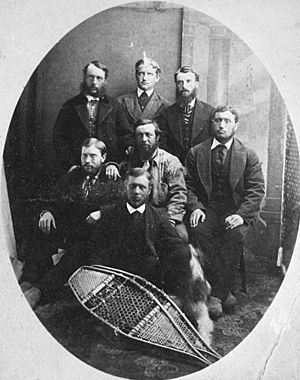Canadian Pacific Survey facts for kids
The Canadian Pacific Survey was a big project in the 1870s and 1880s. Its main goal was to find the best path for the Canadian Pacific Railway. This railway would connect Canada from east to west.
Survey teams explored many areas. They looked for good routes through the Canadian Rockies and other mountain ranges in western Canada. They also searched for a path across the tough Canadian Shield area, north of Lake Superior. This survey helped map parts of British Columbia that had not been explored before. It was a very important part of Canada's exploration history.
Contents
Exploring British Columbia
In British Columbia, Walter Moberly led the survey work. He was a former government official. The teams used steamboats on lakes like the Arrow Lakes and Columbia River. They also used boats on Kootenay Lake, Shuswap Lake, and Seton Lake.
Mapping New Routes
The survey created the first detailed maps of southern British Columbia. This included remote areas like the Coast Mountains icefields. They found many possible routes through the mountains. Two very important discoveries were Rogers Pass and Eagle Pass.
Rogers Pass Discovery
Rogers Pass was found in the Selkirk Mountains. This pass was crucial for the railway. It provided a way through a very difficult mountain range.
Eagle Pass Discovery
Less famous, but still very important, was Eagle Pass. It was found in the Monashee Mountains. This pass also helped the railway find a path through the rugged terrain.
Challenges and Discoveries
The survey teams explored many different routes. Some routes were very challenging. For example, they looked at a path near Bute Inlet. Another route tried to go from the Lillooet River to the coast.
The Stanley Smith Expedition
One team was led by Stanley Smith. They tried to find a route through Ring Pass and the Lillooet Icecap. Sadly, Smith's group disappeared during this difficult journey. Today, glaciers in the Lillooet Icecap are named after him and his brother. This shows the dangers and sacrifices made during the survey.


